How to get a pump out of a well if it is stuck: first aid from professionals
Have you encountered the problem of jamming of submersible equipment in the barrel and the inability to extract it to the surface? Agree, it’s not bad to pull it out on your own, restoring uninterrupted water supply, and at the same time save on the specialist’s departure. But you do not know how to get the pump out of the well without damaging it?
We will tell you how to independently cope with this task - the article discusses the most common causes of pump sticking and methods for removing it. The video recommendations of professionals are given and the equipment used for this is reviewed.
Also in the article are selected photographic materials demonstrating methods for pulling out a submersible pump operated at great depths. The above recommendations will help to cope with the problem if the reason why the unit is stuck, its type and condition of the casing allow this to be done.
The content of the article:
When can the pump get stuck?
In most cases, well owners have problems retrieving pumping equipment, which for a certain time has already worked in development.
The lifting of a deep pump is necessary in the following cases:
- carrying out repair work;
- Maintenance;
- replacement with a more powerful or new pump;
- replacing the flushing pump with a permanent one.
Much less often, the pump wedges in the trunk when trying to lower it to the bottom of the well. The causes of stuck in this case are, as a rule, the mismatch of the size of the pump and the diameter of the casing or the ingress of a foreign object into the string, which interferes with the descent of the unit.
These two reasons are easily removable: pump size and model it is picked up even before the start of the descent, and a foreign object caught in the casing is removed or pushed down.
To prevent the pump from getting stuck during descent, it is necessary to observe safety measures: carefully inspect the unit and make sure that all its parts are serviceable, avoid foreign objects (stones, tools, packaging) getting into the pipe, use a reliable cable and clamps.

Causes of stuck and their elimination
Problems associated with a stuck pump usually occur when it rises from the well to the surface.
The most common prerequisites by which equipment can get stuck in the barrel:
- sagging cable (cable);
- siltation of a well “on sand”;
- deposits in the well "on limestone";
- damage to the walls of the casing;
- foreign objects getting into the pipe;
- the pump is skewed inside the casing;
- cable break.
If your pump is stuck in aquifer, then the right decision is to call specialists who have the experience and the necessary equipment to safely remove the unit.
But in some cases, you can try to get the pump yourself, identifying and eliminating the cause of its jam. Consider the described causes and methods for eliminating them in more detail.
Reason # 1 - cable slack when lifting
If there is a sagging cable or electric cable used to lift the pump, the unit gradually stretches up worse and worse, and stops at a certain point. This is because a sagging cable or power cable has wound around the pump housing.
The algorithm for pulling out a pump stuck with a sagging cable or cable:
- Lower the pump to the bottom and carefully align the loop formed by slowly swinging the cable in different directions and pulling it up.
- If only a cable is used for lifting, do not forget that the pump is also equipped with an electric cable and a hose, which must be synchronized with each other in order to avoid sagging of one of the elements and the formation of loops.
- Secure all three elements with clamps. Mounting must be done every 1-1.5 meters.
- Slowly and gently raise the pump.
This is the most common and easily solved problem. To prevent sagging of the cable is very simple, for this, when lowering the pump into the well, it is necessary to garter it in the casing every 2-3 m, so that it always remains under slight tension.

Reason # 2 - siltation of a well “on sand”
Siltation of wells with a sandy bottom occurs due to infrequent or incorrect operation. In this case, the pump is in a muddy “trap” and you can get it by alternately pulling and loosening the cable, while slowly swinging the unit in different directions. Thus, it is possible to free the equipment from sludge deposits.
In unused workings, sludge can harden, therefore, before removing the aggregate, deposits must first be washed out. To do this, take a fire hose or flexible hose, through which water is supplied to the bottom of the well.
Soaking sludge can take from 2 to 48 hours. To check whether the pump is free of sludge, it is necessary to periodically try to raise it, swinging from side to side. If the device does not give in, then do not apply excessive force, let the soaking of the sludge continue.
The problem of pump overgrowth with sludge occurs if the well has not been cleaned for several years. The annual preventive cleaning of the hydraulic structure and the downhole filter completely eliminates the problem of siltation, and hence jamming of equipment.
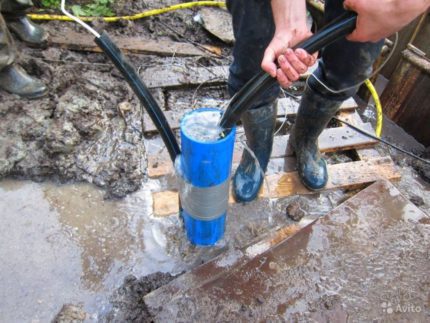
Reason # 3 - limestone deposits
Water produced water well of fractured limestone, contains many salts and metals, which, when interacting with oxygen, form a solid precipitate. Such sediment can be seen on the walls of the casing.
Exactly the same deposits accumulate on the casing of the pumping equipment, forming salt growths, the layer of which can reach 5 cm. It is clear that when the pump is raised, its dimensions increased due to deposits will not allow it to pass through the casing.
In this case, there are three ways to solve the problem:
- Flushing the well with water. She is sent to the barrel under high pressure. This method is good when there is little deposits, and they lend themselves to erosion. In this case, after a high-pressure erosion, the pump rises up by means of a cable or cable.
- The use of "folk" anti-scale. Instead of special powders, citric or acetic acid is taken, diluted in water and poured into the wellbore. Under the influence of acid, salt deposits disintegrate. This method can only be used on a pump, the further operation of which is not planned, because acids can damage its internal mechanisms.
- Use of chemicals. Anti-limescale detergents for washing machines, dishwashers, and kettles are perfect for this. The powder must be dissolved in hot water in accordance with the manufacturer's instructions and pour the resulting solution into the well. To increase the effectiveness of anti-scale products, it is recommended to turn on the pump (if it is working) so that the water starts to move.
The disadvantage of the latter method is its high cost: you will need at least 20 packs of anti-scale, and in some cases it is necessary to repeat the procedure 2-3 times.

Reason # 4 - casing wall damage
When lifting the pump, it may become stuck due to mechanical damage. casing pipe.
Such damage includes:
- dent in the casing;
- flattened edge of the pipe;
- weld roughness;
- offset welded parts, etc.
A characteristic symptom that indicates that the pipe was damaged as an obstacle to the upward movement of the pipe is a dull thud and jamming of the unit, which until now had been moving along the alignment without problems.
In this situation, a slight change in the position of the pump can help, it must be tilted and slowly rotated while lifting up. Please note that it is necessary to tilt just “a little”, otherwise you risk breaking the cable by dropping the device into the well.
Do not make excessive efforts when trying to push the pump through a difficult section, this will lead to complete jamming of the unit inside the well. Practice shows that with minor deformations of the casing and small dimensions of the pump, this method helps in most cases.
If the dimensions of the device are slightly smaller than the cross-section of the casing or the damage to the string is significant, then it will not be possible to get the pump on your own, and in some cases this is beyond the reach of specialists.
To prevent jamming of the equipment due to casing deformation, it is necessary to carry out high-quality installation of casing strings in compliance with all technological standards and correctly select the unit according to its dimensions.
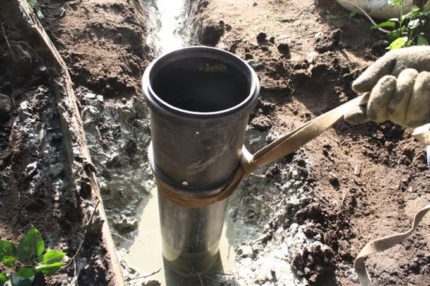
Reason # 5 - hit by foreign objects
The most unpleasant and dangerous situation, which, however, is very easy to prevent. Most often, tools, fasteners, debris, and trimming plastic bottles get into the casing. To escape this, it is necessary to carefully prepare for lifting the pump, removing all unnecessary in the area of work.
If a foreign object nevertheless falls into the pipe and interferes with the lifting of the equipment, then the following steps can be taken:
- Gently and slowly, without making any effort, shake the pump from side to side, if possible - a small object can slip into the well, freeing the way for the unit.
- If it is impossible to move the pump up, and the device goes down without problems, it is necessary to lower the pump a bit and try to get the fallen object using a net, hook or rope with a loop.
- In some cases, you can try to push a fallen object with a hard cable or crowbar. This must be done very carefully, as There is a high risk of the lifting cable breaking and damage to the pump casing. Excessive efforts should not be made in this case.
If these measures were not enough, and the pump was completely stuck in the well due to the ingress of a foreign object between its casing and the walls of the casing, then you must stop trying to solve the problem yourself.
You should call a team of specialists who will remove the obstacles and raise the pump to the surface without damaging it.
Reason # 6 - pump misalignment inside the pipe
The reasons for the pump skew can be a slack in the cable, a sharp jerk of the lifting cable, lifting the unit with an electric cable, etc. The following signs indicate the presence of bias: the pump rose without problems, but at a certain point the lift slows down and stops, while there is no impact.
In no case do you need to continue to pull the device out of the well, as this will lead to even more distortion and jamming! The only solution to the problem is to loosen the cable tension and, lowering the pump, try to return it to its original position.
To do this, the lifting cable must be rotated, gradually pulling the pump up, if the unit is stuck again, then you can try to rotate the cable in the other direction.When lifting is carried out using a cable and an electric cable, then alternately manipulating them it is quite easy to return the device to the desired position.
It is advisable to do all this if the pump moves freely in the well up to a certain point and goes down without problems. If the unit is stuck in the well and does not have free play, it is necessary to call specialists who will remove the device using special tools without harming the pump and the well.
Reason # 7 - open cable break
The breakage of the lifting cable is the most difficult case in which the pump falls to the bottom of the well or gets stuck in the casing. First aid for cable breakage is to stabilize the unit.
For this, a hose and an electric cable are used. If the pump has small dimensions and weight, then with the help of a cable and a hose it can be carefully pulled to the surface, despite the fact that these elements are not intended for this. However, after applying this method, most often pump replacement to the new unit.
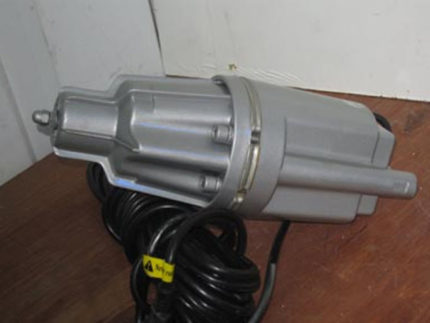
If the pump has a lot of weight, then you can’t pull on the power cable, this will probably lead to its breakage. In this case, you need to act promptly: take a thick rope with a metal hook tied to it.
Then gently lower the rope, trying to hook the pump and pull it up. Hose and power cable are used to secure and align the device during lifting.
When the cable broke suddenly and the pump fell into the well with a hose and an electric cable, you can try to get it yourself using the following method:
- We take a metal rod of such a length that it reaches the fallen / stuck unit.
- We attach a special nozzle in the form of a corkscrew to the rod. A blacksmith, a turner-milling machine operator can make such a twisted nozzle, or any ready-made suitable element can be used as a nozzle. It is important that the diameter of the turns of the nozzle be such that the rod passes unhindered through the casing.
- The nozzle is attached to a rod, on the second end of which a metal rod is put on, which makes it possible to ensure the rotation of the structure.
- We lower the rod with the nozzle into the well and with the help of the rod we screw the “corkscrew” into the pump casing. We lift the unit together with the dangling cable and hose.
This is a fairly complex and difficult to implement method, suitable only for shallow wells. Naturally, further use of equipment raised by such a “corkscrew” will be impossible. It is impossible to remove a fallen pump so as not to harm it yourself, and the services of professionals in this case can be expensive for you.
If it is impossible to raise the submersible pump to the surface in any way, then there are two solutions:
- well conservation and new drilling;
- crushing the pump into parts by a special drilling rig and removing it in parts.
Which way to choose? In each case, the owner of the well decides for himself, given many factors.It happens that a well has developed its resource or its operation is difficult for some reason, then it is easier and faster to drill a new one.
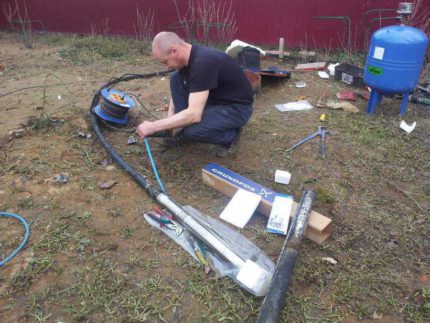
General guidelines for safe lifting
Jamming of a submersible pump is easier to prevent than fixing the problem later.
This requires a few simple recommendations:
- Use a reliable, durable and rigid cable. The cable that comes with the submersible pump often does not meet these requirements. Do not skimp, get a high-quality cable and fasteners (clamps) to it made of stainless steel.
- Do not use a multi-piece hose. If the hose included in the pump kit is not long enough, do not renew it; it is better to buy a new one-piece piece. This will reduce the risk of breakage and provide additional insurance in case of cable breakage.
- Choose the right size pump. It should be 2/3 less than the diameter of the casing. Thus, the risk of jamming the unit will be significantly reduced even if the pipe is deformed or foreign objects fall into the well.
- Be sure to set the head. It will protect the well from falling debris and various objects.
And remember: using the above methods, in no case do not use brute force, trying to pull the unit to the surface. This will lead to an aggravation of the problem: the pump gets stuck even more tightly inside the barrel, the cable may break, and the wall and casing can become deformed.
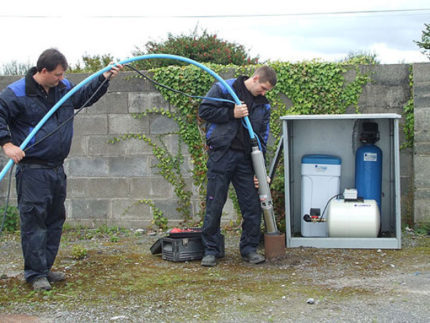
Conclusions and useful video on the topic
Video # 1. How to get a pump if it is stuck in a well and how to prevent a jam:
Video # 2. Removing a stuck pump on its own in the following video:
A submersible pump stuck in a well is a serious problem that needs to be addressed immediately. In this case, the “do no harm” rule applies anywhere, therefore, when attempts to remove equipment have failed, the best solution is to call specialists.
Be sure to follow the rules of installation and operation of the well, timely clean it and then you will never encounter such problems.
We are waiting for your stories about how you yourself removed the stuck pump from the wellbore. Perhaps you have a more effective method in your arsenal or have questions. Please write comments in the block below.

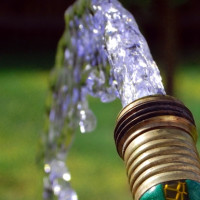 Water purification from the well: what to do if the water in the well is cloudy or turns yellow
Water purification from the well: what to do if the water in the well is cloudy or turns yellow  The head for the well: device, types of structures, installation and installation rules
The head for the well: device, types of structures, installation and installation rules  Do-it-yourself flushing of the well after drilling: step-by-step briefing on the work
Do-it-yourself flushing of the well after drilling: step-by-step briefing on the work 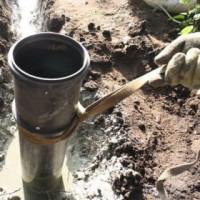 How to pull a casing from a well: rules for dismantling
How to pull a casing from a well: rules for dismantling 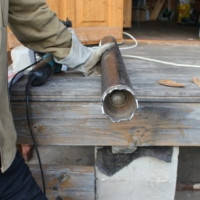 Well bumper: device, options and do-it-yourself manufacturing schemes
Well bumper: device, options and do-it-yourself manufacturing schemes 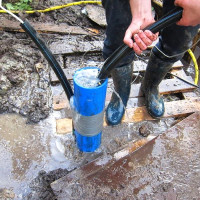 Do-it-yourself well cleaning: a review of common clogging causes and best cleaning methods
Do-it-yourself well cleaning: a review of common clogging causes and best cleaning methods  How much does it cost to connect gas to a private house: the price of organizing gas supply
How much does it cost to connect gas to a private house: the price of organizing gas supply  The best washing machines with dryer: model rating and customer tips
The best washing machines with dryer: model rating and customer tips  What is the color temperature of light and the nuances of choosing the temperature of the lamps to suit your needs
What is the color temperature of light and the nuances of choosing the temperature of the lamps to suit your needs  Replacement of a geyser in an apartment: replacement paperwork + basic norms and requirements
Replacement of a geyser in an apartment: replacement paperwork + basic norms and requirements
I encountered this problem a couple of times, the pump stuck in the well, and it was tight, the first time I began to panic, pull the cable, but I was lucky and I did not ruin anything. In fact, both times my cable sagged when lifting. The second time I already knew an approximate reason and acted more measuredly. Both times, he lowered the pump back to the bottom and swaying the cable removed the loop.
A couple of times also the pump fell. For the first time, I panicked how to get the unit out of the well.He tried something himself, a neighbor came, began to lower the pole with the loop attached to it, so they got it a couple of times. When the pump fell a second time, I already climbed the Internet, I studied the information on lifting the pump from the well and did everything myself. And thanks for helping people!
Trying to pull a stuck pump out of the well is a very crap job. And what to do, so you can lose a well. It’s fortunate that you have a shallow well and you get the pole.
good article